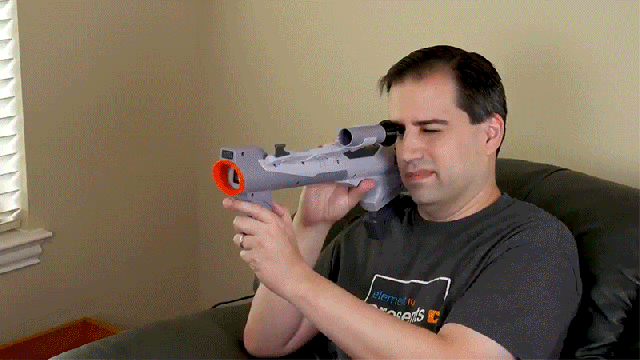Despite a renaissance in outdated gaming tech, there’s a small blip in the history of retro gaming hardware that has all been all but abandoned in the emulation scene: light guns. The way the technology worked simply isn’t compatible with modern TVs and screens, so if you want to get something like the Super Nintendo’s Super Scope working again, you either need to find an old tube TV, or perform a monumental hack on the hardware like Andy West did.
So why aren’t old accessories like the Super Scope compatible with modern display technology? It all comes down to how these displays create an image. On a flatscreen TV, the millions of tiny pixels are all illuminated at the exact same time to produce a series of images every second. On an old CRT — or cathode ray tube — display, an electron gun fires a precise beam at a glass surface covered in a chemical that glows when it’s hit, illuminating just a single pixel. Magnets are used to deflect where the electron gun is aiming, and pixels are illuminated, one-by-one, row-by-row, to eventually create an image that fills the entire screen. The process happens so quickly that the human eye doesn’t see the pixel-by-pixel scanning occurring, but a light sensor can.
[referenced id=”1240734″ url=”https://gizmodo.com.au/2020/08/the-very-best-retro-game-consoles/” thumb=”https://gizmodo.com.au/wp-content/uploads/2020/08/14/fs0zdsaw3yzba5xvzut2-300×169.jpg” title=”The Very Best Retro Game Consoles” excerpt=”Modern video games and consoles offer a narrative experience that rivals Hollywood blockbusters, but also require a hefty commitment of your time to play through. Sometimes you just want to dive into the action, and your favourite 8 and 16-bit games of yesteryear are perfect for that. Retro gaming is…”]
The original Nintendo Zapper used a slightly different approach for games like Duck Hunt where a series of quick black and white frames were flashed to determine where the player was aiming. But as Today I Found Out points out, Nintendo’s patent for the NES’ Zapper also outlines a more complex approach, which the Super Scope used, where a focused light sensor on a peripheral could detect individual pixels being illuminated on screen by a CRT’s electron gun, and by keeping track of when the pixel was detected, its location could be accurately calculated, letting a game know where a player was aiming. Without that row-by-row process of illuminating pixels one-by-one, the Super Scope simply doesn’t work.
Or, at least, it doesn’t work without a major upgrade.
While West has managed to preserve the overall aesthetics of the Super Scope, the solution he came up with required a lot of additional hardware to both the scope and the TV, as well as custom software and 3D-printed enclosures. To compensate for the lack of row-by-row scanning on the TV he wanted to play on, he upgraded the screen with four IR LED emitters mounted to each corner. The Super Scope was gutted and replaced with a tiny digital camera on the front and a filter so that all its sensor can really see when pointed at the TV was the four glowing dots in each corner.
When the Super Scope is pointed directly at the centre of the TV, the four glowing dots detected by the camera form a perfect square. But as the scope moves from side to side, the shape of that square gets warped, and that can be used to accurately calculate where it’s being aimed.
The custom system sounds simple enough, but to get it all working properly West had to hijack the video signal coming out of the SNES, and even upgrade the Super Scope with vents and a cooling fan so the Arduino inside wouldn’t overheat. In other words, this is not a quick “just changing this setting on your TV” hack. For most of us with a Super Scope collecting dust on a shelf somewhere, it’s neat to see it working again, but West’s upgrades are too daunting to try for ourselves.
